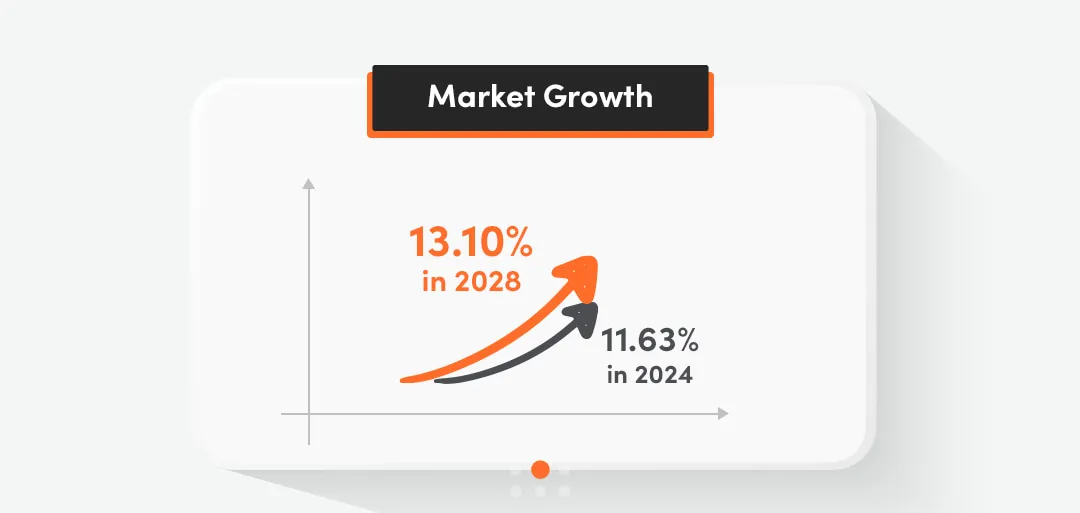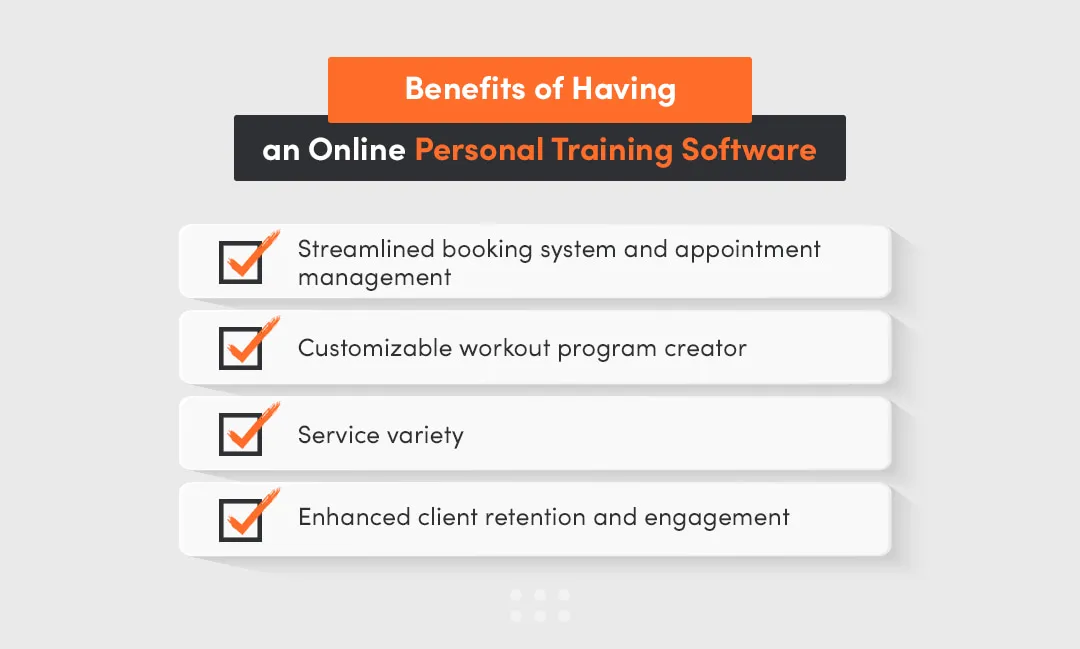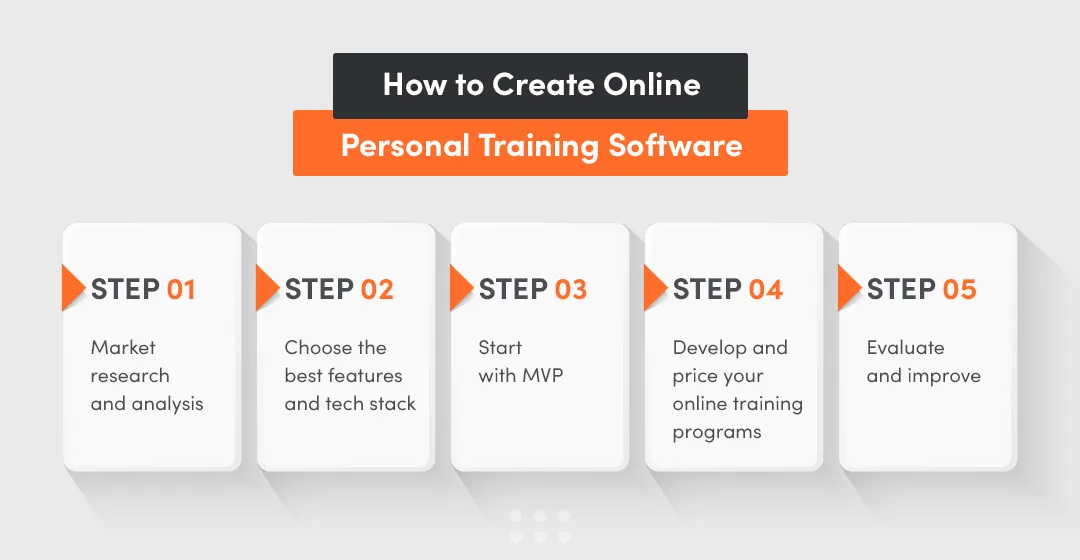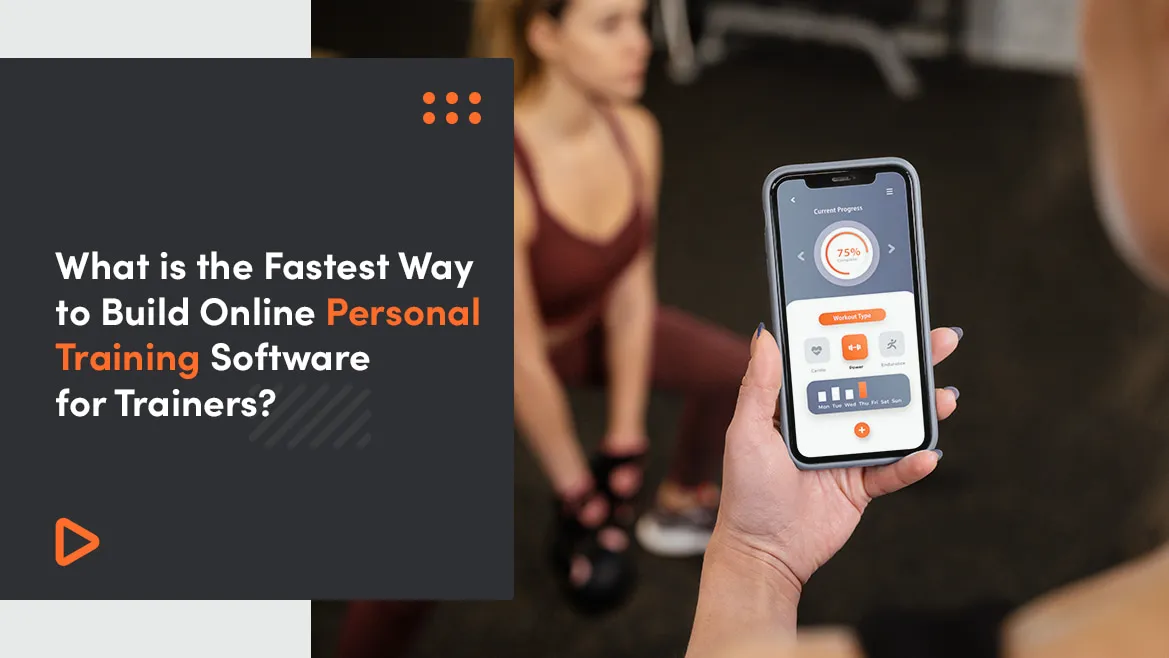Business owners are increasingly recognizing the value of investing in personal training applications, driven by the remarkable growth of the global fitness training software market. Valued at USD 6,9 million in 2022, this market is projected to rise to USD 2,5 million by 2031, growing at a robust CAGR of 15.8%. The projected user adoption rates and revenues are particularly noteworthy.

By 2024, it is projected that 11.63% of the target market will be using these platforms, and this figure is expected to rise to 13.10% by 2028. The average revenue generated from each user (ARPU) is projected to be US$17.84.
In terms of revenue, the market is poised for significant growth. Specifically, in 2024, it is expected to generate a substantial US$2 million, with a large portion of this revenue coming from the U.S.
This is an excellent opportunity for business owners to invest in custom application development to differentiate their brand and capture a significant market share. Custom personal training applications offer unparalleled flexibility and scalability, which is crucial for future growth.
While ready-made SaaS solutions and white-label software provide quick market entry, they don’t often deliver the customized experience and flexibility that custom solutions offer. Custom-built applications can be designed to meet specific business needs, offer better integration capabilities, and the ability to evolve with the business. Therefore you will also learn what might be the best and fastest way for you to build online personal training software for trainers.
What will you learn from this article?
- The benefits of having online personal training software.
- The types of training apps.
- Steps for creating personal training software or apps.
- The top SaaS training platforms, including their pros and cons.
- Influencers App - how are they different?
-
The US market will generate USD 2 million in 2024 just from personal training apps.
-
North America and Europe lead the market with high technology adoption rates and the presence of major players.
-
Asia-Pacific region is also experiencing significant growth due to increased health awareness.
-
Custom-built apps offer better flexibility, scalability, and integration than ready-made SaaS solutions.
-
Personal training software simplifies appointment management, reducing administrative tasks.
-
Different apps cater to specific needs, such as activity tracking, dietary management, and personalized workout guidance.
-
Development steps include market research, selecting features, starting with an MVP, and continuous evaluation.
Benefits of Having an Online Personal Training Software
Online personal training software offers numerous benefits that can transform how trainers manage their businesses and interact with clients. Simplified scheduling systems to advanced features, these platforms increase efficiency and improve the quality of service provided. Below, we explore the key advantages of incorporating personal training software into your fitness business strategy.

Streamlined Booking System and Appointment Management
Online personal training software transforms how trainers manage appointments and bookings. Trainers no longer need to manage scheduling through texts, emails, and phone calls. Instead, they can use a centralized platform where clients can submit their session requests.
With more efficient scheduling, trainers can spend less time on administrative duties and more time focusing on client training and expanding their business.
Customizable Workout Program Creator
Personal training software offers a standout feature that significantly enhances the trainer's ability to create customized workout programs. With this functionality, trainers can easily select exercises from a vast library and incorporate them into personalized routines using a simple drag-and-drop interface. Additionally, trainers have the flexibility to design their unique exercises and save these along with templates for future use.
This level of customization not only improves the quality of the training programs but also ensures they are designed to meet the needs of each client, thereby increasing client satisfaction and loyalty.
Service Variety
Personal training software consolidates various services into one convenient platform. It enables trainers to extend beyond workout programs, incorporating additional services like nutritional advice, progress monitoring, and communication tools.
This all-in-one approach improves client experience and helps trainers attract more clients and increase revenue, setting them apart from competitors focusing on limited aspects of training.
Enhanced Client Retention and Engagement
Personal training software tracks client progress, and presents it in easy-to-understand charts and graphs, giving clients clear, visual proof of their improvements. This visual motivation is essential for keeping clients enthusiastic and committed to their fitness goals. Additionally, the software’s communication tools, such as auto messages, help clients feel supported and connected, enhancing their overall experience and loyalty.
Types of Personal Training Apps
Personal training apps are designed to cater to various needs, including activity tracking, dietary management, personalized workout guidance, etc. Each app type serves a specific purpose and includes unique features that enhance user experience and contribute to achieving personal health goals. Let's explore the different personal training apps below:
Activity Tracking Apps
Activity tracking apps are designed for those looking to monitor and enhance their physical activity.
These apps are adept at tracking daily movements such as walking, running, or swimming, and are valuable for both casual fitness enthusiasts and serious athletes.
They offer features like step counting, heart rate monitoring, and automatic recognition of different activity types, which help log exercises accurately. Additionally, these apps provide graphical insights into the user’s progress. A well-known example of such an app is Fitbit.
Diet and Nutrition Apps
Diet and nutrition apps are invaluable for anyone looking to manage their eating habits and nutritional intake effectively.
These apps can help users track their calorie consumption, provide custom diet plans, and offer detailed nutritional information on various food items.
Features typically include meal planning capabilities, water intake tracking, and body fat analysis. These comprehensive tools cater to those aiming for specific dietary goals - whether weight loss, muscle gain, or maintaining general health. MyFitnessPal is a prominent example of such an app.
Fitness Apps for Wearable Devices
Fitness apps for wearable devices like smartwatches are custom-made to help users monitor their health metrics.
These apps integrate seamlessly with the device, delivering real-time health data directly to the user.
Features often include activity timers, progress notifications, and interactive feedback from trainers. Such apps are perfect for tech-savvy fitness enthusiasts who prefer to receive updates and track their health metrics on the go. Apple Fitness+ is an example of a fitness app that excels in providing these capabilities.
Personal Fitness Trainer Apps
Personal fitness trainer apps connect users with professional trainers, providing personalized workout routines and the flexibility to train anytime, anywhere.
These apps typically include instructional videos, customizable training programs, and direct communication tools to stay connected with a trainer.
They are designed for individuals seeking personalized fitness guidance and can adapt to various fitness levels and goals. Nike Training Club is a prominent example of such an app.
Try our developers.
Free for 2 weeks.
No risk. Just results. Get a feel for our process, speed, and quality — work with our developers for a trial sprint and see why global companies choose Selleo.
How to Create Online Personal Training Software
Creating online personal training software involves several crucial steps to ensure it meets the needs of both trainers and clients. Each step plays a vital role in the overall development process, from understanding the market to continuous evaluation and improvement. Below is a detailed guide:

Step 1. Market Research and Analysis
Conducting thorough market research is crucial for developing successful personal training software. This involves analyzing current market conditions, trends, and geographical distribution. The online personal trainer software market is expected to grow significantly due to rising demand for personalized fitness programs, increasing health consciousness, and rising adoption of digital fitness platforms.
North America and Europe lead the market with high technology adoption rates and the presence of major players, while the Asia-Pacific region is also experiencing significant growth due to increased health awareness.
It is easier to identify opportunities when one understands market drivers, such as the demand for virtual fitness solutions and technological advancements. It is also important to recognize barriers like data privacy concerns and competition from traditional trainers. Addressing challenges such as establishing credibility without face-to-face interactions and ensuring data security is also important. Comprehensive market research and analysis inform strategic decisions and shape the development process.
Step 2. Choose the Best Features and Tech Stack
Selecting the right features and tech stack is vital for building effective personal training software. Below are three top tech stacks and their benefits:
Node.js: This backend technology is excellent for building scalable and real-time mobile and web applications. Its efficiency in transferring data from server to client makes it ideal for fitness activity-tracking apps. Node.js supports rapid development with numerous open-source libraries and frameworks.
MongoDB: Ideal for apps that require extensive data analysis and real-time notifications. MongoDB’s scalability options and solid framework architecture (MVC) make it a great choice for applications needing robust data handling and future expansion capabilities.
React Native: It is an excellent choice for developers looking to create high-performing applications quickly. With React Native, developers can write code once and deploy it seamlessly on Android and iOS platforms. Built on JavaScript, React Native includes vital components that work effectively across both systems. Its framework provides developers access to numerous libraries and tools, enabling the incorporation of advanced features like real-time data analysis, GPS tracking, and social media integration.
Step 3. Start with MVP
Starting with an MVP is a strategic approach that allows developers to test the core features of the app before full-scale development. This involves creating a prototype to evaluate the functionality and gather user feedback, which helps refine the final product and ensures better resource allocation and cost efficiency.
The typical timeline for launching a fitness app includes time for research, analysis, planning, design, implementation, and testing.
Design and front-end development may require about 2000 hours for one platform, back-end development about 1500 hours, and testing up to 500 hours.
These timelines can vary depending on the company's approach and the scope of the MVP, which could potentially be completed much faster.
Step 4. Develop and Price Your Online Training Programs
Creating and pricing your online training programs involves defining your unique value proposition. Start by knowing your ideal clients' demographics, fitness goals, pain points, and motivations to customize your value proposition to their needs.
Next, identify what sets you apart, such as specialized certifications, training techniques, experience, success stories, or unique approaches to fitness. Your USP should be clear and compelling. Focus on how your training will help clients achieve their fitness goals, improve health, and enhance quality of life. You can use specific data to showcase effectiveness, such as success rates and average client gains. Equally important, share success stories and positive feedback to demonstrate your value.
Afterward, develop a concise, engaging pitch that conveys who you are, what you offer, and why clients should choose you. Explain how your training addresses challenges like time constraints and lack of motivation. You can provide potential clients with a sample of your services through strategy or discovery calls.
Finally, develop professional materials that reflect your value proposition, using engaging visuals and persuasive copy. Ensure your value proposition is consistently communicated across all channels to build trust and reinforce your brand's credibility.
Step 5. Evaluate and Improve
Continuous evaluation and improvement are essential for maintaining the app’s relevance and effectiveness. Regularly gather feedback from users to identify areas for enhancement. This might involve updating features, fixing bugs, or adding new functionalities based on evolving user needs and market trends. Monitoring the app’s performance and staying updated with the latest technological advancements ensures that your personal training software remains competitive and user-friendly.
TOP SaaS Training Platforms - Are They Worth the Attention?
SaaS training platforms are essential for personal trainers and fitness businesses to optimize operations and enhance client engagement. This section evaluates three prominent platforms: TrueCoach, ABC Trainerize, and TeamUp, examining their strengths, weaknesses, and flexibility.
TrueCoach
TrueCoach is designed to help personal trainers create customized workout plans, track client progress, and facilitate effective communication. Its user-friendly interface, extensive exercise library, and efficient customer support make it popular among fitness professionals. Additionally, it allows clients to upload videos for feedback, enhancing the overall training experience.
TrueCoach provides considerable flexibility and customization, making it ideal for small to mid-sized personal training businesses. With its features, trainers can create customized workout plans and connect with popular fitness applications like MyFunnyApp, giving them the resources they need to provide comprehensive and personalized training services.
Pros
- It has a user-friendly interface, which makes it easy to navigate for both trainers and clients.
- TrueCoach offers an extensive exercise library for varied and comprehensive workout plans.
- Its customizable workout plans enable trainers to tailor programs to meet individual client needs.
- It boasts responsive and helpful customer service.
- Clients can upload workout videos for trainers to provide detailed feedback.
- Its integration with MyFitnessPal makes it seamless to track nutrition and fitness data.
Cons
- The mobile version has usability problems, which can be inconvenient for trainers who need to access the platform on the go.
- Some exercise videos in the library have low quality, which can detract from the user experience.
- The platform’s tracking and metrics features are not comprehensive enough for detailed performance analysis.
ABC Trainerize
ABC Trainerize is a comprehensive coaching software and mobile app designed to enhance member engagement and retention, digitize coaching services, and grow personal training profit centers. It allows fitness coaches and businesses to create and market digital training packages, introducing additional revenue streams. Suitable for individual fitness coaches, clubs, and studios, ABC Trainerize helps build stronger member/trainer relationships and adds a digital component to traditional locations.
ABC Trainerize offers significant flexibility and customization, making it a strong choice for individual trainers and larger fitness businesses. Trainers can create personalized workout and nutrition plans while automating administrative tasks to enhance efficiency.
Pros
- The platform is intuitive and easy to navigate for both trainers and clients.
- Trainers can create highly personalized workout plans tailored to each client's needs.
- The platform automates administrative tasks, allowing trainers to focus more on coaching.
- It provides tools for tracking clients' nutritional intake
Cons
- Users report occasional bugs and glitches in the mobile app.
- It is missing certain desired features, which may limit the platform's utility.
- While it includes nutrition tracking, some users noted that these features need more detail and comprehensiveness.
TeamUp
TeamUp is a robust fitness management software designed to simplify the management of fitness businesses, whether in-person, online, or on-demand. It caters to gyms, studios, personal trainers, and fitness clubs by providing an all-in-one toolset, including detailed reporting and enhanced membership management. With TeamUp’s free switching service and unlimited support, businesses can easily transition and set themselves up for success. The platform simplifies managing bookings, enhances client communication, and offers customizable features and reliable payment solutions, ensuring member satisfaction and business growth.
Pros
- TeamUp offers a high level of customization to meet specific business needs.
- It integrates seamlessly with other systems, improving functionality.
- TeamUp offers reliable and responsive customer support.
- It automates bookings, communication, and administrative tasks, saving time and reducing manual work.
- The platform provides comprehensive analytics that help track business performance and make informed business decisions.
- TeamUp is intuitive, making it easy for fitness business owners to manage operations.
Cons
- Some users find the aesthetic elements of the platform less appealing.
- The API has certain limitations which might affect integration with other advanced systems.
- Some users report difficulties with configuring settings.
Influencers App - How Are They Different?
Influencers apps are designed to help fitness influencers manage their clients, create customized workout plans, and monetize their content. Below, we will compare three popular influencers apps, Alive by Whitney Simmons, Sweat, and THRST, with traditional SaaS training platforms like TrueCoach, ABC Trainerize, and TeamUp. The differences and similarities between these apps will be highlighted.

Differences
- Influencers apps like Alive, Sweat, and THRST, typically offer branded experiences tied to the personalities and fitness philosophies of the influencers behind them.
- Influencers usually create unique fitness content that reflects their brand and style and is exclusive to the app. This might include specific workout styles, motivational content, and personalized health tips. For example, Sweat, a personal training app featuring co-founder and elite head trainer, Kayla Itsines, offers high-intensity workouts and challenges that reflect her specific training style.
- Traditional SaaS platforms like TrueCoach, ABC Trainerize, and TeamUp focus on providing a customizable toolkit for trainers to manage client workouts, schedules, and progress. Fitness professionals can upload or create their content, using whatever methods or materials they prefer.
Similarities
- Both influencer apps and traditional platforms offer tools for tracking workouts, nutrition, and progress. They typically provide support for video content, workout logs, and health metrics.
- Many apps in both categories use a subscription model, where users pay a monthly or annual fee to access the platform's features and content.
- Both types of platforms are designed with the ultimate goal of improving users’ fitness levels, though the approach and delivery might differ significantly based on the target audience.
Development Approach
Influencer Apps: These are usually custom-developed to suit the specific vision and style of the influencer, aiming to differentiate themselves in a crowded market by capitalizing on the influencer’s existing fan base.
Traditional SaaS Apps: These apps are more likely to be ready-made solutions offering customization options. They are built to be scalable and adaptable, serving a wide range of fitness professionals and business models.
Conclusions
It's really hard to determine the fastest way to build online personal training software for trainers. It all depends on your business goals and whether you want to use a ready-made solution (which might be faster but less tailored to individual needs) or if you prefer to opt for custom software. Two primary approaches to creating online personal training software for trainers include using ready-made SaaS platforms or developing custom software. Although each option has specific advantages, custom software development is particularly beneficial for trainers who want a solution tailored to their unique needs and long-term business goals.
Custom software development, though potentially more resource-intensive initially, offers unmatched flexibility and scalability.
Trainers can design features specifically for their training style and client management needs, incorporating sophisticated tracking tools, personalized workout and nutrition plans, and branding that resonates with their specific audience. This can significantly enhance client engagement and retention, as the software feels more personal and relevant to users.
On the contrary, ready-made solutions are ideal for small brands and companies as they help avoid higher initial costs associated with custom development.





